- Established 1982 -HOME: www.hiltonpond.org
THIS WEEK at HILTON POND Subscribe for free to our award-winning nature newsletter (Back to Preceding Week; on to Next Week) |
A WEEK OF WOODPECKER ACTION
Close to dusk on 2 April we trapped our first Ruby-throated Hummingbird of 2019, a second-year male banded locally last August (that's the new arrival, below left). We were excited to see and handle a hummer again and figured this individual would end up being our “Bird of the Week.” That, of course, was before we looked out the office window of the Center’s "Why did that previous sentence end in an exclamation mark?" you might ask. Well, we could easily use !! or !!! or !!!! of them, and not just because Red-headed Woodpeckers might be the most eye-pleasing woodpeckers in North America (see below). The reason for our thrill was it was only the THIRD sighting of this species at the Center in 38 years, and the first time coming to a feeder!
All text, maps, charts & photos © Hilton Pond Center Our initial encounter here with Red-headed Woodpeckers (RHWO) was 'way back in March 1982 when we brought five-year-old Billy Hilton III down from Minnesota as we closed on this property that became Hilton Pond Center for Piedmont Natural History. That day we saw two RHWO pecking around on an old stump and considered them to be an omen of good things to come at our new locale. The second red-headed occurrence was in September 2014 when we watched one fly high over the pond while we were looking for migrating Common Nighthawks. This week's RHWO continued to visit the suet basket as the sun rapidly descended. We absolutely wanted to get some photos before dark, if possible, and hurriedly set up camera and 400mm lens on a tripod. Fortunately, the bird made one more feeding trip and we were able to get off a few shots, including the one above we entitled “Red, White, and Blue (And Black).” Although quite colorful, Red-headed Woodpeckers are sexually monomorphic, with males and females identical in plumage and size. Although some Red-headed Woodpeckers are apparent year-round residents (see map), others migrate back and forth between winter sites in the South and breeding grounds further north. Thus, it’s possible our" red-headed was a “one-day wonder” that gorged on our generous suet offerings, but only while passing through in migration. Gambling that our RHWO—even if a migrant—would at least spend the night at the Center, we rose before dawn the morning after our initial sighting to deploy a mist net between the suet feeders the woodpecker had used. The strategy worked perfectly; at 8:15 a.m. the red-headed swooped from one feeder to another and got caught in the net.
All text, maps, charts & photos © Hilton Pond Center As we carefully removed this rarity from the soft mesh, we were reminded woodpeckers have several tools with which they can inflict pain on a well-meaning bander. The most obvious is a heavy-duty chisel-shaped bill, well-adapted for excavating nests or feeding holes in tree trunks—and equally able to make puncture wounds in human skin. Even though we were able to avoid any pecking as we extricated the Red-headed Woodpecker and held it in the "bander's grip" (see photo above), its other weapons caused some pain as it scratched and dug into hands and fingers with eight sharply pointed decurved claws. Ouch! Fortunately, we were able to free the RHWO with minimal damage to our epidermis and brought it to the banding table for processing. Spectacular at the feeder, this brilliantly plumaged tri-colored woodpecker was even more breathtaking up-close.
All text, maps, charts & photos © Hilton Pond Center After banding was finished and measurements were made, discretion overtook vanity and we pulled on a glove—lest the RHWO peck and lacerate as we held it securely in the "photographer's grip" (above). Only twice before have we worn gloves to handle a bird, and they weren’t owls or hawks. The first was in Minnesota when we captured a feisty hook-billed Northern Shrike, and later in Belize when we saw stars from the vise-like bite of a Rufous-browed Peppershrike. Upon release the Red-headed Woodpecker flew to a nearby tree, ruffled its feathers, and took off across Hilton Pond. It’ll be interesting to see if it hangs around, or if someday some bander within a more northerly part of its breeding range is startled to capture a RHWO with a band already on its left leg. We took numerous photos of the woodpecker (see a sampling below) before letting it go unharmed. (The whole process from capture to release took only about ten minutes.)
All text, maps, charts & photos © Hilton Pond Center The photo above is of the underside of the Red-headed Woodpecker's left wing, showing the reduced #10
All text, maps, charts & photos © Hilton Pond Center Most birds have feet that are anisodactyl, with three toes in front and a hallux in back. Members of the Picidae (Woodpecker Family) have zygodactyl feet, with two toes in front and two behind. In the Red-headed Woodpecker foot above, what was
All text, maps, charts & photos © Hilton Pond Center As with other picids, the tail of a Red-headed Woodpecker is forked, with feathers that are very stiff and pointed. This,
All text, maps, charts & photos © Hilton Pond Center At first glance it may appear the white on a Red-headed Woodpecker's wing is from the primary feathers, but that's
All text, maps, charts & photos © Hilton Pond Center In a Red-headed Woodpecker, white is not limited to the
All text, maps, charts & photos © Hilton Pond Center Like most picids, the Red-headed Woodpecker has a tongue
All text, maps, charts & photos © Hilton Pond Center A closer view above of a Red-headed Woodpecker's tongue shows barbs are indeed limited to the tip, which is hard and horn-like-- From the numerous photos above you can probably sense our excitement over finally capturing a Red-headed Woodpecker--now the 127th species banded at Hilton Pond Center since 1982! Even though Red-headed Woodpeckers can be locally common in optimum habitat—open deciduous woodlands, wetlands, or orchards and parks with lots of dead snags in which to excavate nest holes--their overall numbers have declined precipitously in recent years. For now we're happy to have seen and photographed just one--our 49th “Yard Bird” of 2019!
All text, maps, charts & photos © Hilton Pond Center DOWNY WOODPECKER INVASION We were indeed stunned this week to catch what became our first-ever Red-headed Woodpecker banded at Hilton Pond Center, but that wasn’t the only member of the Picidae to hit our mist nets. Although we also captured three Red-bellied Woodpeckers (two new ones, plus one recapture banded last year), the real startle came on 6 April 2019 when we caught NINE Downy Woodpeckers. Of these, four were new; from the remaining five, three were banded last year, one in 2017, and one—now a fourth-year bird—from 2016.
All text, maps, charts & photos © Hilton Pond Center The more important evaluation of our nine Downy Woodpeckers (DOWO) was that SEVEN of them were females, and all these were in breeding condition with well-developed brood patches that indicate they are currently incubating eggs, or possibly sitting on young. (That's a female downy above, lacking the red nape patch of the male.) Assuming DOWO have long-term monogamous pair bonds—which reportedly is the case—each of those seven females must have a male out there, which in turn means there are at least SEVEN pairs of Downy Woodpeckers at or very near Hilton Pond Center. This is especially remarkable when one source says a pair of downies may require a breeding territory of as much as 24 acres! In winter it's hard to look at any of our suet feeders without seeing a downy loading up; this behavior has continued with the arrival spring, so at most times during the day we can spot a DOWO or two. Nonetheless, we never would have expected our little 11-acre Center would have a population density of “at least” SEVEN pairs of Downy Woodpeckers. And we emphasize “at least” because it’s entirely likely we didn’t catch all the local downies in the seven hours we deployed mist nets. (Incidentally, ALL nine DOWO were caught in the SAME net strung between two suet feeders.)
All text, maps, charts & photos © Hilton Pond Center Of the two male Downy Woodpeckers caught this week, one was new, and one was banded last year. (Note the red nape patch of the male DOWO in the photos above and below.) We should mention both these males ALSO had brood patches, indicating that in this species both sexes incubate and brood. (The same is true of most of the 300-plus woodpecker species worldwide.) In DOWO, males usually take the night shift with eggs or chicks while the female occupies a roost hole nearby.
All text, maps, charts & photos © Hilton Pond Center In 38 years at Hilton Pond Center we’ve banded 233 Downy Woodpeckers. It’s entirely possible the number of local downies will increase in coming years as hardwood trees on the property come of age and provide dead limbs for nest holes--and especially since we will continue to offer suet and other woodpecker sustenance on a year-round basis. For now, it will be interesting as we continue to run mist nets this spring to see whether more adult Downy Woodpeckers are captured, thereby indicating the local population is even bigger than what was documented by this week's take. Sometime before the month is out we anticipate seeing recent fledglings in the nets, proof their downy parents successfully shared duties in incubating eggs and raising young. With each pair capable of producing 3-8 eggs per clutch, there could be a LOT of those little woodpeckers buzzing and pecking around Hilton Pond very soon. Let’s see, eight chicks times seven pairs of Downy Woodpeckers equals . . . . All text, maps, charts & photos © Hilton Pond Center RED-HEADED WOODPECKERS & BT3
All text, maps, charts & photos © Hilton Pond Center PERSONAL POSTSCRIPT: If you’re an active birder, you may be aware of the 25 March passing of Bill Thompson III, editor of Birdwatcher’s Digest. I’d known Bill since the mid-1990s and spent many days in the field with him in years that followed. One of my best memories is our collaborative “Hawk Gawks and Warbler Walks” in West Virginia, during which I showed folks how to recognize raptors in migration while BT3 instructed about intricacies of fall warbler identification. (That's Bill above with the gray brim hat and glasses, and me on the right in the green vest. The photo depicts "Warbler Walk" day in October 2012 at New River Birding & Nature Center in West Virginia.) Bill (below left with writer/artist/musician wife Julie Zickefoose) died far too young of pancreatic cancer at age 57, but not before making major impact on the art of birding. As a scientist I objectively examined the Red-headed Woodpecker I caught and banded this week, but my spiritual side makes me wonder if the unexpected arrival at Hilton Pond of BT3’s favorite bird shortly after his passing was more than coincidental, or even a little supernatural. I always say in nature “everything is connected to everything else,” but maybe those connections don’t stop when an organism ceases to function on this planet. Maybe Bill was . . . . Bill Thompson III often said he wished he could fly and, in fact, wrote and performed with his group (The Raincrows) a song entitled “Dream of Flying Dream.” As I study birds and nature at Hilton Pond I do what I can on behalf of wildlife, trying to make this place the best bird feeding station around. I thought about all that this week when I caught BT3’s favorite bird and I wonder, just wonder . . . . ---Bill Hilton Jr. All text, maps, charts & photos © Hilton Pond Center
Checks also can be sent to Hilton Pond Center at: All contributions are tax-deductible on your Don't forget to scroll down for Nature Notes & Photos, |
|---|
|
"This Week at Hilton Pond" is written and photographed by Bill Hilton Jr., executive director of Hilton Pond Center for Piedmont Natural History
|
|
|
Please refer "This Week at Hilton Pond" to others by clicking on this button: |
|

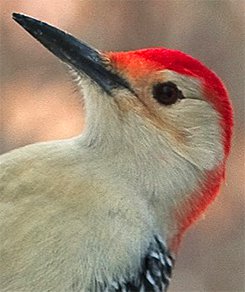 The first week in April brought plenty of woodpecker activity to
The first week in April brought plenty of woodpecker activity to 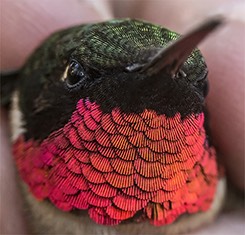 old farmhouse on the evening of 3 April and saw a woodpecker at a nearby suet feeder, where a moment before had sat a diminutive Downy Woodpecker. The new bird was noticeably larger than the downy and was not one of several Red-bellied Woodpeckers that also partake of our suet smörgåsbord. Nope, this bird was deep blue-black . . . with brilliant white wing patches . . . and completely red from the neck up. Yep, we were looking at what unmistakably was a Red-headed Woodpecker!
old farmhouse on the evening of 3 April and saw a woodpecker at a nearby suet feeder, where a moment before had sat a diminutive Downy Woodpecker. The new bird was noticeably larger than the downy and was not one of several Red-bellied Woodpeckers that also partake of our suet smörgåsbord. Nope, this bird was deep blue-black . . . with brilliant white wing patches . . . and completely red from the neck up. Yep, we were looking at what unmistakably was a Red-headed Woodpecker! 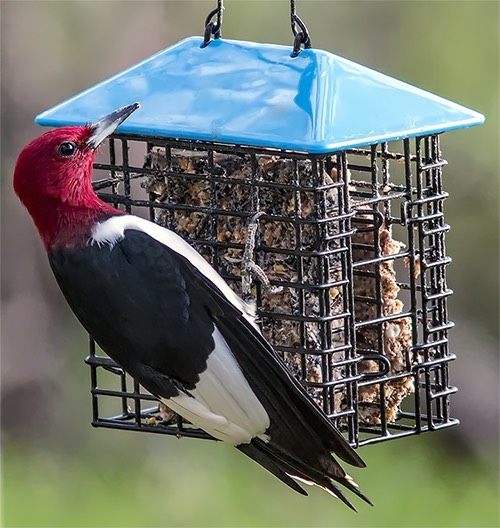
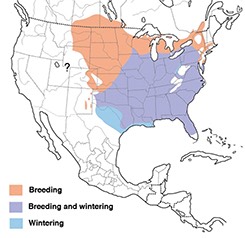 Even in-hand during breeding season they apparently can’t be sexed because both genders get brood patches and both help incubate and care for nestlings. They breed and overwinter across the eastern U.S.
Even in-hand during breeding season they apparently can’t be sexed because both genders get brood patches and both help incubate and care for nestlings. They breed and overwinter across the eastern U.S. 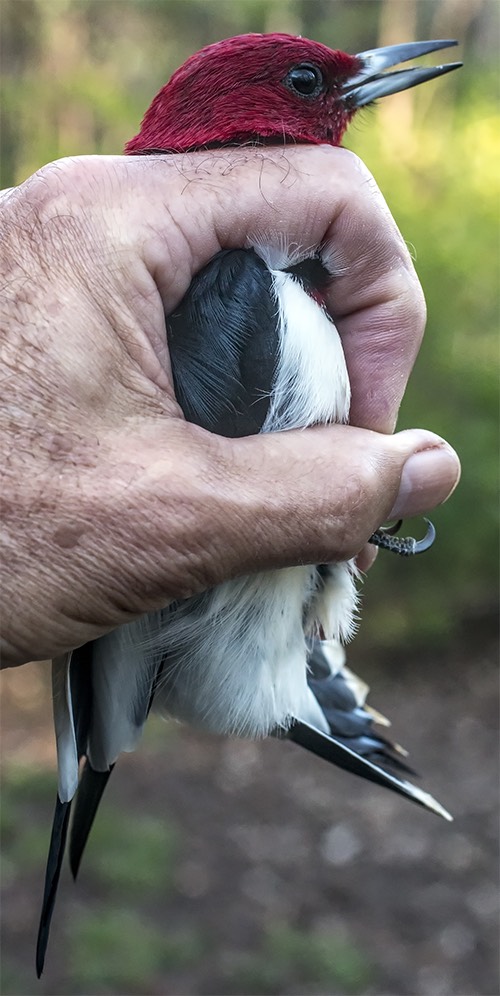
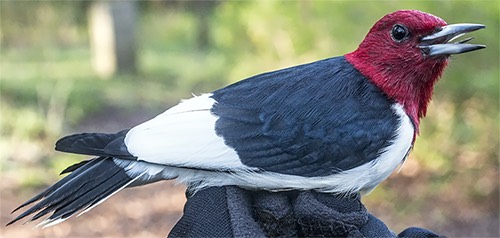
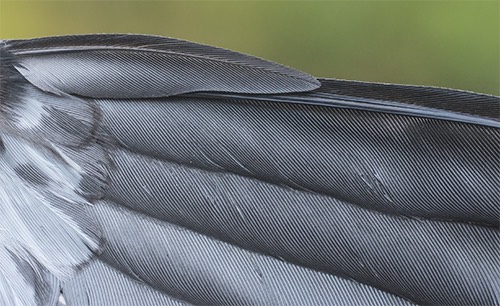

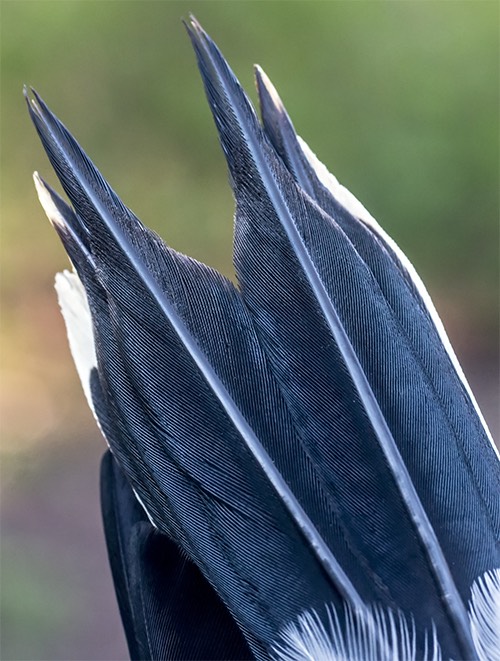
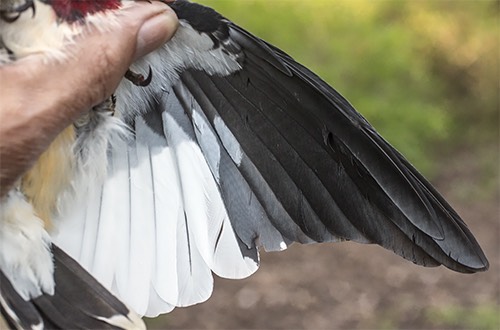
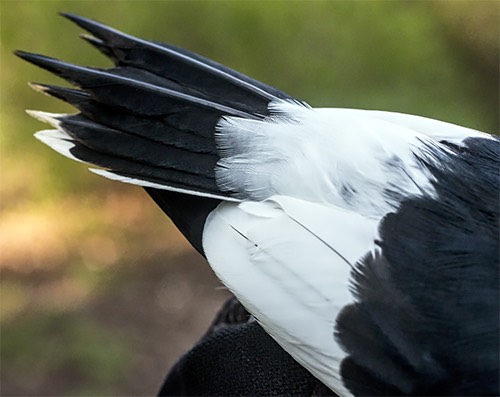
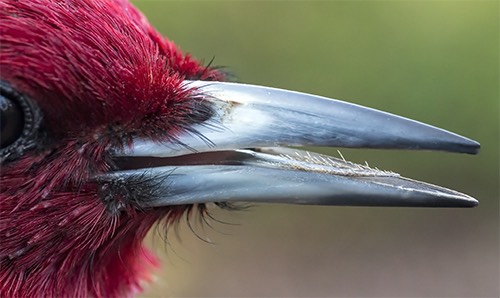
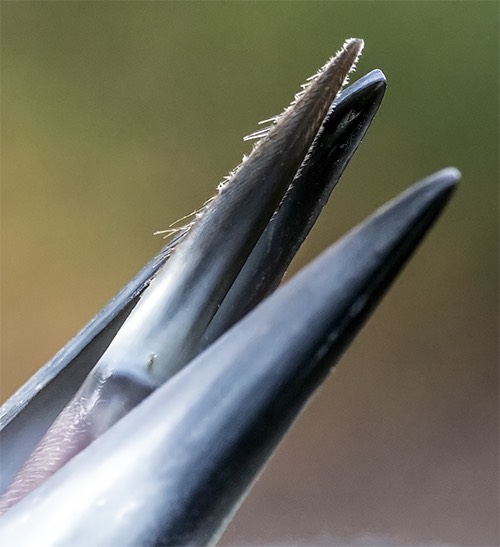
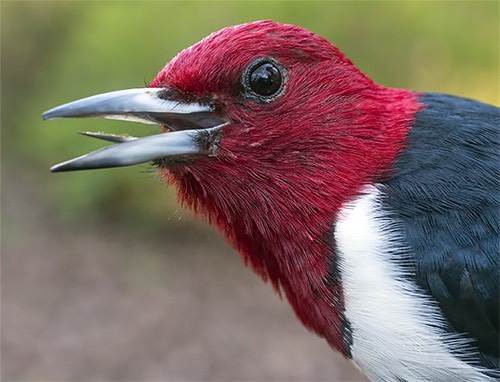


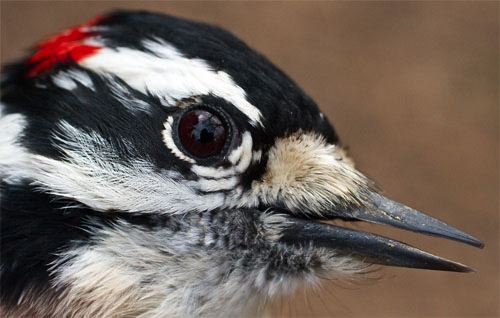
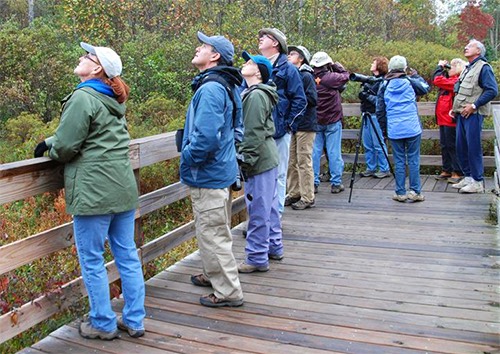
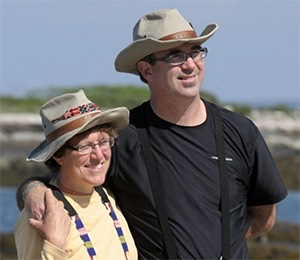 He traveled far and wide as an advocate for birds and bird conservation and education, observing many exotic avian species the rest of us see only in photographs. Despite his far-flung adventures, when he returned to the family farm near Whipple, Ohio, he steadfastly maintained his favorite bird was the home-grown Red-headed Woodpecker.
He traveled far and wide as an advocate for birds and bird conservation and education, observing many exotic avian species the rest of us see only in photographs. Despite his far-flung adventures, when he returned to the family farm near Whipple, Ohio, he steadfastly maintained his favorite bird was the home-grown Red-headed Woodpecker.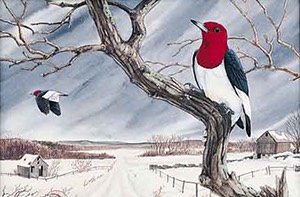 The lyrics describe how wonderful it would be to soar and glide with birds, looking down at Earth from above. And one line goes something like: “We’ll visit all the best bird feeders.”
The lyrics describe how wonderful it would be to soar and glide with birds, looking down at Earth from above. And one line goes something like: “We’ll visit all the best bird feeders.”









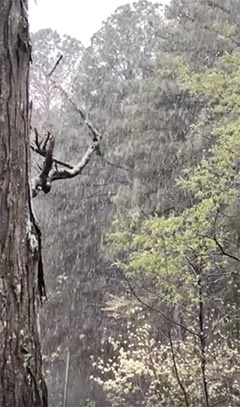
 Please report your
Please report your